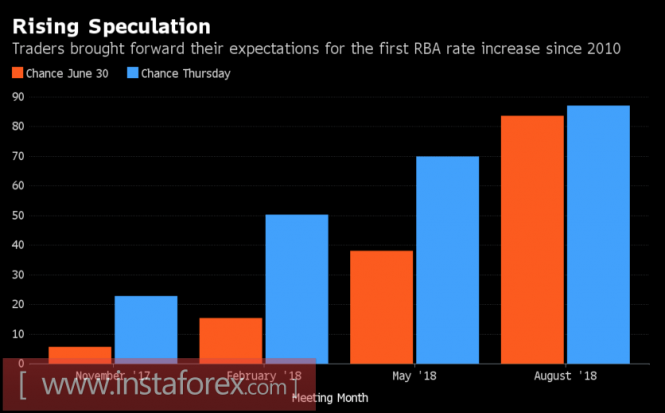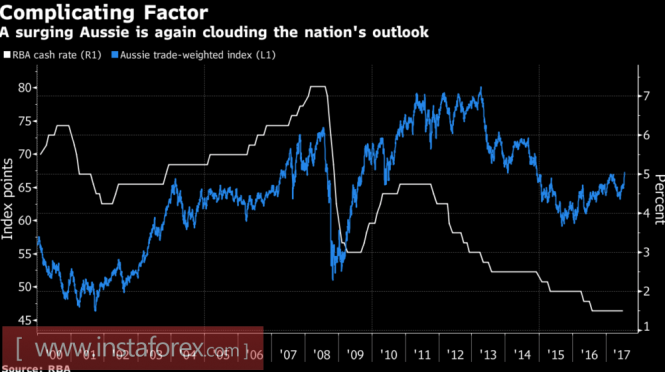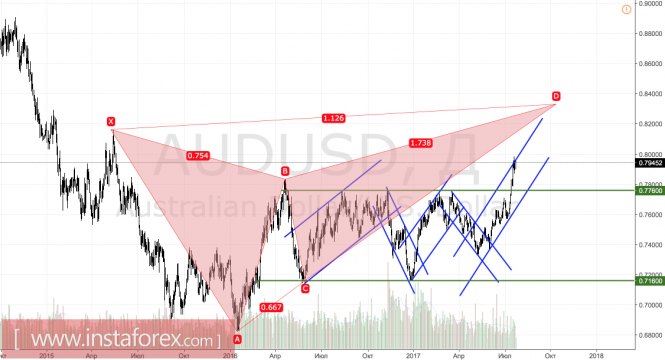Since the beginning of the year, the Australian dollar has gained more than 10% relative to the U.S. dollar and is fighting for first place with the euro on the list of the G10 best performers. Firmly high appetite for risk, low volatility in financial markets, increased activity of carry traders, recovery of iron ore prices, improved data of the Green Continent and higher likelihood that the RBA tightens monetary policy are the main drivers for strengthening the "Aussie". The Reserve Bank does not like the strengthening of the Australian currency.
Over the past couple of weeks, the AUD/USD pair has increased by 4% amid the hawkish notes of the protocol of the last RBA meeting, China's GDP and the Australian labor market's strong data. A big role in the acceleration of the upward trend was played by political scandals surrounding Donald Trump and the Fed's willingness to change the previously planned path of hiking the rate for federal funds. At the same time, according to Credit Agricole, the global appetite for risk will remain stable as long as the Federal Reserve adheres to the practice of dependence of its decision on incoming data on the US economy. This would be possible only if US data continues to disappoint, then the chances for a monetary tightening will be moved to 2018 and the AUD/USD pair will continue the rally. Furthermore, the likelihood of a hike in the cash-rate from the current 1.5% is gradually increasing.
The dynamics of the probability of tightening monetary policy of the RBA

Source: Bloomberg.
Improving the external background and health of the Australian economy indicates the need to complete the cycle of monetary easing, which started in 2011. At that time, the main interest rate was at the level of 3.25%. According to HSBC, strengthening the "Aussie" by 5% is equivalent to a cash-rate rise of 25 basis points. At the same time, since the beginning of May, the trade-weighted rate of the Australian dollar firmed by 6%.
Dynamics of cash-rate and the Australian dollar rate

Source: Bloomberg.
Moreover, a number of banks warned that the "Aussie" was vulnerable to adjustment in the conditions of the RBA's growing discontent with the national currency and the inflated positioning in the futures market. The AUD/USD pair reacted sensitively to the verbal intervention of Guy Debelle, the deputy head of the Reserve Bank. He noted that the Aussie's high rate complicates the reorientation of the economy from mining to services. Talking about the equilibrium interest rate does not mean that the RBA is going to raise it. Simply, GDP is moving slightly lower than it was in the 1990s.
Important factors for the medium-term prospects of the AUD/USD are data releases on Australian inflation, US GDP for the second quarter and the results of the FOMC meeting. CPI will likely slow down, however, correction would most probably be used for buying the "Aussie".
Technically, the implementation of the inverted "Splash and Shelf" pattern with the exit of prices outside the long-term consolidation range of 0.716-0.776 raises the risks of the uptrend development in the direction of the target by 127.2% on the "Perfect Butterfly" pattern.
AUD/USD, daily chart

